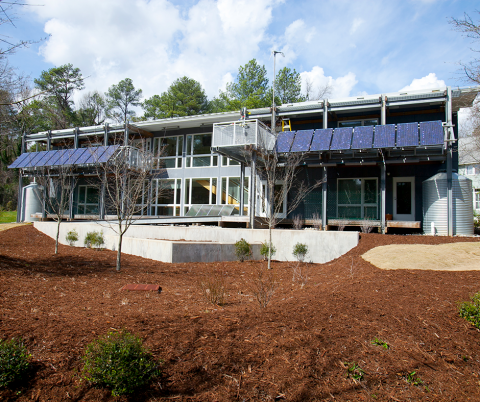Energy and the Environment: Design and Innovation (2024-2025)
Background
To explore the breadth of issues that confront our society in its need for clean, affordable and reliable energy, students partner with faculty on a year-long project resulting in prototypes of new energy technologies, systems or approaches.
Project Description
This project team will identify, design and prototype new energy technologies, systems or approaches. Previous teams have focused on building better green roofs, strategies for recycling plastic waste, maximizing solar power efficiency, wind turbine technology, an energy-harvesting speedbump, human energy harvesting, a smart HVAC system, algae windows, hog farm chemical recovery, a land footprint calculator, hand dryers on campus, Stirling engines fueled by neglected heat, storm energy, wind kite energy, student transportation, island grid resilience and emergency backup power, a folding electric skateboard, alternative refrigeration, the potential of incorporating green building concepts into college dorms, alternative use cases for flywheel energy storage and renewable microgrids in South Africa. Other projects have included a strategy proposal for encouraging growth in the hydrogen economy, a human-powered bicycle to filter urban water systems, electric and solar-powered vehicles, a biogas-powered generator and a green emergency power system.
Subteams will address the tradeoffs among technological design choices, environmental impacts, economic viability and other issues related to use. The goal is to produce a useful prototype and evaluate its environmental benefits and viability. Projects will be selected and defined during the fall semester and completed during the spring semester.
While some subteams may concentrate on building a physical prototype, alternatives outputs are possible, including statistical analysis, mathematical modeling or computer simulation. Ideas for projects will come from students, with input from faculty, companies, organizations or competitions.
Anticipated Outputs
Prototypes (physical or conceptual) and accompanying evaluation of environmental and social benefits; target market and basic business plans; presentation of results in the form of poster session as well as class presentations and final report
Student Opportunities
Ideally, this team will include 3 graduate students and 15-20 undergraduate students, forming subteams of 5-7 and working on projects of their choice. Undergraduate backgrounds could include environmental sciences and policy, engineering, public policy, economics, chemistry, earth science or international studies; however, students in all majors are welcome to apply.
Graduate students will serve as project managers for subteams.
This project fulfills the capstone for the undergraduate Certificate in Energy and Environment, as well as the senior project for some engineering majors.
Timing
Fall 2024 – Spring 2025
-
Fall 2024: Select and define projects; form subteams
-
Spring 2025: Complete prototypes and evaluation of environmental benefits and viability; submit final report; present results
Crediting
Academic credit available for fall (half credit) and spring (full credit) semesters; this project also satisfies the capstone project course for the undergraduate Certificate in Energy and the Environment
See earlier related team, Energy and the Environment: Design and Innovation (2023-2024).
Image: Smart Home gardens, by Jared Lazarus/Duke University

Team Leaders
- Emily Klein, Nicholas School of the Environment-Earth and Climate Sciences
- Josiah Knight, Pratt School of Engineering-Mechanical Engineering & Materials Science
